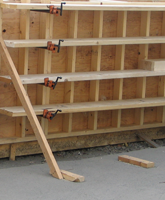







Formwork
Following completion of the foundation beam, we constructed formwork from plywood and dimensional lumber, connecting it to the concrete beam below. The formwork was further reinforced using pipe clamps and horizontal walers to contain the outward forces of compaction. This method is in keeping with widely-available literature on rammed earth construction and approximates the form-ties used in site-cast concrete,. For larger projects, the use of modular formwork manufactured for use in site-cast concrete would represent considerable savings in time and material, but for a modest-sized project building it from lumber was the most sensible approach. As the wall was built in two sections, separated by a gate at the center, we formed one side first and reused the formwork on the second side after the first was rammed. This approach allowed us to apply lessons learned in the first side to the second, and resulted in significant material savings.
Mixing the clay, delivered to the site in a plastic state, with sand and aggregates to final consistency proved to be the most challenging aspect of building the wall. During the laboratory phase we managed the soil creation with an industrial bread mixer, which was very effective for small quantities but not appropriate to full-scale fabrication. Our solution involved modifications to the revolving paddles of a gasoline powered plaster mixer. This produced a machine capable of mixing reasonably-sized batches of the engineered soil, which were then deposited in formwork and compacted. A variety of mixtures were incorporated in the wall for research purposes, each marked by an embedded steel plaque identifying it. The mixing method limited the size of aggregate used in construction; crushed stone larger than three-quarters of an inch caused problems for the machine.